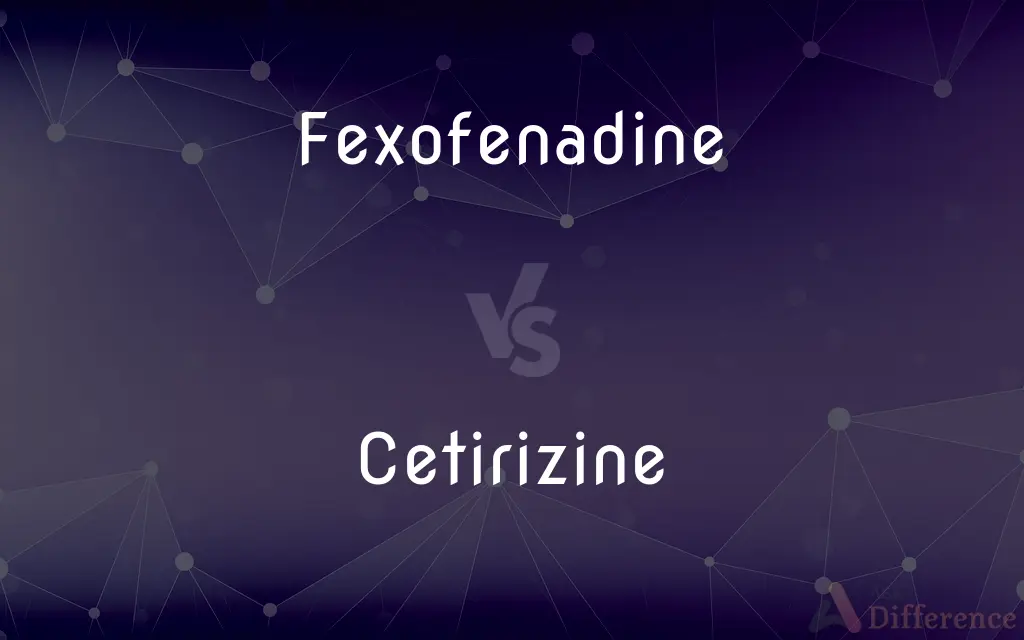Fexofenadine vs. Cetirizine — What's the Difference?
By Tayyaba Rehman — Published on January 31, 2024
Fexofenadine and Cetirizine are both antihistamines; Fexofenadine is less likely to cause drowsiness, while Cetirizine can be more sedating but may work faster.

Difference Between Fexofenadine and Cetirizine
Table of Contents
ADVERTISEMENT
Key Differences
Fexofenadine is a second-generation antihistamine known for its minimal sedative effects, making it suitable for people who need to avoid drowsiness. It is commonly used for treating seasonal allergies and hives. Cetirizine, also a second-generation antihistamine, is effective for similar conditions but has a higher likelihood of causing drowsiness compared to Fexofenadine. It is often recommended for allergic rhinitis and urticaria.
The chemical structure of Fexofenadine allows it to have less penetration into the central nervous system, reducing the risk of sedation. It is metabolized mainly through the intestinal tract, minimizing liver involvement. In contrast, Cetirizine has a slightly higher ability to cross the blood-brain barrier, which can lead to sedative effects. It undergoes hepatic metabolism, involving the liver more in its processing.
Regarding onset of action, Fexofenadine typically takes about an hour to start working and has a longer duration of action, making it suitable for once or twice daily dosing. Cetirizine, on the other hand, may work slightly faster but often requires dosing once daily due to its shorter duration of action compared to Fexofenadine.
Fexofenadine is often recommended for individuals who need allergy relief without the risk of drowsiness, such as those needing to drive or operate machinery. It is also a preferred choice for elderly patients due to its safer side effect profile. Conversely, Cetirizine may be chosen for its faster onset of action and is sometimes preferred for more immediate relief, although caution is advised due to its sedating properties.
In terms of side effects, Fexofenadine is associated with fewer anticholinergic effects, such as dry mouth and urinary retention, making it a safer option for patients with certain health conditions. Cetirizine, while generally safe, may cause more of these anticholinergic side effects and is usually prescribed with caution in patients with conditions like glaucoma or enlarged prostate.
ADVERTISEMENT
Comparison Chart
Sedative Effect
Less likely to cause drowsiness
Higher likelihood of causing drowsiness
Metabolism
Mainly intestinal, minimal liver involvement
Hepatic metabolism, involving the liver
Onset of Action
Takes about an hour, longer duration
Works faster, shorter duration
Recommended Use
For patients needing non-sedative options
Preferable for quick allergy relief
Side Effects
Fewer anticholinergic effects
More anticholinergic effects
Compare with Definitions
Fexofenadine
It's known for minimal central nervous system penetration, reducing drowsiness.
As a pilot, he preferred fexofenadine to avoid the sedative effects of other antihistamines.
Cetirizine
Cetirizine is a second-generation antihistamine often used for quick allergy relief.
He took cetirizine for immediate relief from his seasonal allergy symptoms.
Fexofenadine
Fexofenadine is a non-sedative second-generation antihistamine used for allergies.
She took fexofenadine to relieve her hay fever symptoms without feeling drowsy.
Cetirizine
Cetirizine undergoes hepatic metabolism, involving the liver.
His doctor considered his liver health before prescribing cetirizine for his allergies.
Fexofenadine
Fexofenadine is metabolized mainly in the intestine, sparing the liver.
Due to his liver condition, his doctor recommended fexofenadine for his allergies.
Cetirizine
It can cross the blood-brain barrier, potentially causing drowsiness.
She avoided driving after taking cetirizine due to its sedative effects.
Fexofenadine
It has a longer duration of action, suitable for once or twice daily dosing.
Fexofenadine's longer duration meant she only had to take it once in the morning.
Cetirizine
Cetirizine can cause more anticholinergic side effects than Fexofenadine.
He switched from cetirizine to another antihistamine to avoid dry mouth.
Fexofenadine
Fexofenadine is preferable for patients sensitive to anticholinergic side effects.
Fexofenadine was her choice, as it didn't cause the dry mouth she got from other antihistamines.
Cetirizine
It typically requires once daily dosing due to its shorter action duration.
Taking cetirizine once a day was convenient for her busy schedule.
Fexofenadine
A nonsedating antihistamine, C32H39NO4, used in its chloride form to treat allergic rhinitis and allergic skin disorders.
Cetirizine
A nonsedating antihistamine, C21H25ClN2O3, used in the form of its hydrochloride to treat allergic rhinitis and other allergic disorders.
Fexofenadine
A second-generation antihistamine drug used in the treatment of hay fever and similar allergies.
Cetirizine
(pharmaceutical drug) A major metabolite of hydroxyzine, an antihistamine used in the treatment of allergies, hay fever, angioedema, and urticaria.
Common Curiosities
Is Fexofenadine safe for elderly patients?
Yes, its safety profile makes it a good choice for the elderly.
How long can one take Fexofenadine?
It can be taken long-term, but consult a doctor for prolonged use.
Can Cetirizine be used for chronic urticaria?
Yes, cetirizine is effective in treating chronic urticaria.
Are there any foods to avoid with Fexofenadine?
Avoid taking it with apple, orange, or grapefruit juice as they can reduce its effectiveness.
What is Fexofenadine used for?
It's used for treating allergies and hives with minimal risk of drowsiness.
Is Cetirizine likely to cause sleepiness?
Yes, cetirizine has a higher chance of causing drowsiness compared to fexofenadine.
Can Fexofenadine be taken by people with liver issues?
Yes, due to its minimal liver involvement, it's often safer for those with liver issues.
How fast does Cetirizine work?
Cetirizine usually starts working quickly, often within an hour of ingestion.
Is Cetirizine suitable for children?
Yes, but dosage and suitability should be confirmed by a pediatrician.
Does Cetirizine affect driving ability?
Due to its sedative effects, it may impair driving or operating machinery.
How does Cetirizine compare with older antihistamines?
It causes less drowsiness than first-generation antihistamines but more than some second-generation ones.
Does Fexofenadine interact with other medications?
It has fewer interactions, but always check with a healthcare provider.
Can Cetirizine cause dry mouth?
Yes, as an antihistamine, it can have anticholinergic effects like dry mouth.
Is Fexofenadine effective for pet allergies?
Yes, it's commonly used to treat reactions to pet dander.
Can I take Fexofenadine during pregnancy?
Consult a doctor, as the safety of fexofenadine in pregnancy is not fully established.
Share Your Discovery

Previous Comparison
Cyst vs. Polyp
Next Comparison
One-Dimensional Array vs. Two-Dimensional ArrayAuthor Spotlight
Written by
Tayyaba RehmanTayyaba Rehman is a distinguished writer, currently serving as a primary contributor to askdifference.com. As a researcher in semantics and etymology, Tayyaba's passion for the complexity of languages and their distinctions has found a perfect home on the platform. Tayyaba delves into the intricacies of language, distinguishing between commonly confused words and phrases, thereby providing clarity for readers worldwide.
















































